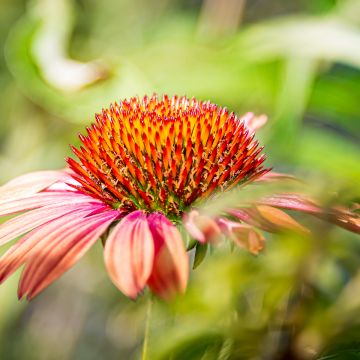

Hemerocallis Cosmopolitan - Daylily


Hemerocallis Cosmopolitan - Daylily
Hemerocallis Cosmopolitan - Daylily
Hemerocallis Cosmopolitan
Daylily
This item cannot be shipped to the selected country
Delivery charge from €5.90
Delivery to Corse prohibited
More information
Schedule delivery date,
and select date in basket
This plant carries a 12 months recovery warranty
More information
We guarantee the quality of our plants for a full growing cycle, and will replace at our expense any plant that fails to recover under normal climatic and planting conditions.
From €5.90 for pickup delivery and €6.90 for home delivery
Express home delivery from €8.90.
Delivery to Corse prohibited: UE law prohibits the import of this plant from mainland France to Corse as part of the fight against Xylella fastidiosa. Please accept our sincere apologies.
More information
Does this plant fit my garden?
Set up your Plantfit profile →
Description
The 'Cosmopolitan' Daylily is a compact variety. Deciduous, this summer perennial has a tuft of thin, long and arched leaves which are a bright green colour. From June to July, straight stems bear charming small round flowers with fringed dark pink edges, almost red, illuminated by bright yellow stamens. Its abundant and perpetual flowers, in addition to its size, make it especially suitable for planting in balcony pots or borders around a patio. Hardy and robust, plant this daylily in sunny or semi-shade in any type of soil, even clay or dry soil.
The genus Hemerocallis belongs to the family of Hemerocallidaceae. They are perennial and hardy plants with deciduous or semi-evergreen foliage. 'Cosmopolitan', introduced in 1989 by Stamile-G., reaches 50 cm (20in) in all directions. The flowers are smaller than in other varieties, not exceeding 6 cm (2in) in diameter, and are quite open. Individually, they last no more than a day, but they continuously renew themselves between June and July. Daylilies have short rhizomes and fleshy roots. The stems are sturdy and make beautiful bouquets. The foliage is linear and semi-evergreen. Daylilies have short rhizomes and fleshy roots, tolerating dry soils, but they are more opulent and floriferous in damp, rich and deep soil.
Very easy to grow, these plants thrive in both shade and sun. Some of them can be a little invasive, so don't hesitate to divide the clumps every four or five years, preferably in autumn, after flowering. Daylilies are often called 'the perfect perennial plant', due to their vibrant colours, their ability to tolerate any type of environment, but also because of their lack of modesty, as they are beautifully exuberant and go well with other perennials. Plant them in generous clumps in the background of your flowerbeds. Summer bulbs can be planted alongside daylilies. Daylilies will fit perfectly into a romantic garden, with campanulas, penstemons, perennial flaxes or phlox. On a balcony or patio, plant dwarf varieties like 'Cosmopolitan' in large pots of at least 30 cm (12in) deep,. The flowers are edible: they brighten up salads and decorate desserts.
Many varieties have been developed in Japan, where they are very popular. The flowers of these plants come in a wide range of colors and shapes. More than 60,000 cultivars, mostly resulting from hybridization by gardening enthusiasts, are listed, appreciated and studied by international Hemerocallis societies.
Report an error about the product description
Hemerocallis Cosmopolitan - Daylily in pictures


Flowering
Foliage
Plant habit
Botanical data
Hemerocallis
Cosmopolitan
Hemerocallidaceae (Liliaceae)
Daylily
Cultivar or hybrid
Other Hemerocallis - Daylilies
Planting and care
Plant your Hemerocallis 'Cosmopolitan' in good garden soil that is not too heavy with clay and that is enriched with humus and compost. In these conditions, your perennial will have good tolerance towards summer droughts and will not suffer from winter frosts. Very easy to grow, this variety is not susceptible to parasites or diseases, so there is no need to treat it and rodents are not interested in it. Plant by burying the collar 3 to 4 cm (1 to 2in) below the surface. If you plant several of them, do not space them too close together as the gaps will be quickly filled. For a few weeks after planting, it is good to keep the soil moist. Divide the clumps preferably in autumn after flowering.
Planting period
Intended location
Care
This item has not been reviewed yet - be the first to leave a review about it.
Summer flowering perennials
Haven't found what you were looking for?
Hardiness is the lowest winter temperature a plant can endure without suffering serious damage or even dying. However, hardiness is affected by location (a sheltered area, such as a patio), protection (winter cover) and soil type (hardiness is improved by well-drained soil).

Photo Sharing Terms & Conditions
In order to encourage gardeners to interact and share their experiences, Promesse de fleurs offers various media enabling content to be uploaded onto its Site - in particular via the ‘Photo sharing’ module.
The User agrees to refrain from:
- Posting any content that is illegal, prejudicial, insulting, racist, inciteful to hatred, revisionist, contrary to public decency, that infringes on privacy or on the privacy rights of third parties, in particular the publicity rights of persons and goods, intellectual property rights, or the right to privacy.
- Submitting content on behalf of a third party;
- Impersonate the identity of a third party and/or publish any personal information about a third party;
In general, the User undertakes to refrain from any unethical behaviour.
All Content (in particular text, comments, files, images, photos, videos, creative works, etc.), which may be subject to property or intellectual property rights, image or other private rights, shall remain the property of the User, subject to the limited rights granted by the terms of the licence granted by Promesse de fleurs as stated below. Users are at liberty to publish or not to publish such Content on the Site, notably via the ‘Photo Sharing’ facility, and accept that this Content shall be made public and freely accessible, notably on the Internet.
Users further acknowledge, undertake to have ,and guarantee that they hold all necessary rights and permissions to publish such material on the Site, in particular with regard to the legislation in force pertaining to any privacy, property, intellectual property, image, or contractual rights, or rights of any other nature. By publishing such Content on the Site, Users acknowledge accepting full liability as publishers of the Content within the meaning of the law, and grant Promesse de fleurs, free of charge, an inclusive, worldwide licence for the said Content for the entire duration of its publication, including all reproduction, representation, up/downloading, displaying, performing, transmission, and storage rights.
Users also grant permission for their name to be linked to the Content and accept that this link may not always be made available.
By engaging in posting material, Users consent to their Content becoming automatically accessible on the Internet, in particular on other sites and/or blogs and/or web pages of the Promesse de fleurs site, including in particular social pages and the Promesse de fleurs catalogue.
Users may secure the removal of entrusted content free of charge by issuing a simple request via our contact form.
The flowering period indicated on our website applies to countries and regions located in USDA zone 8 (France, the United Kingdom, Ireland, the Netherlands, etc.)
It will vary according to where you live:
- In zones 9 to 10 (Italy, Spain, Greece, etc.), flowering will occur about 2 to 4 weeks earlier.
- In zones 6 to 7 (Germany, Poland, Slovenia, and lower mountainous regions), flowering will be delayed by 2 to 3 weeks.
- In zone 5 (Central Europe, Scandinavia), blooming will be delayed by 3 to 5 weeks.
In temperate climates, pruning of spring-flowering shrubs (forsythia, spireas, etc.) should be done just after flowering.
Pruning of summer-flowering shrubs (Indian Lilac, Perovskia, etc.) can be done in winter or spring.
In cold regions as well as with frost-sensitive plants, avoid pruning too early when severe frosts may still occur.
The planting period indicated on our website applies to countries and regions located in USDA zone 8 (France, United Kingdom, Ireland, Netherlands).
It will vary according to where you live:
- In Mediterranean zones (Marseille, Madrid, Milan, etc.), autumn and winter are the best planting periods.
- In continental zones (Strasbourg, Munich, Vienna, etc.), delay planting by 2 to 3 weeks in spring and bring it forward by 2 to 4 weeks in autumn.
- In mountainous regions (the Alps, Pyrenees, Carpathians, etc.), it is best to plant in late spring (May-June) or late summer (August-September).
The harvesting period indicated on our website applies to countries and regions in USDA zone 8 (France, England, Ireland, the Netherlands).
In colder areas (Scandinavia, Poland, Austria...) fruit and vegetable harvests are likely to be delayed by 3-4 weeks.
In warmer areas (Italy, Spain, Greece, etc.), harvesting will probably take place earlier, depending on weather conditions.
The sowing periods indicated on our website apply to countries and regions within USDA Zone 8 (France, UK, Ireland, Netherlands).
In colder areas (Scandinavia, Poland, Austria...), delay any outdoor sowing by 3-4 weeks, or sow under glass.
In warmer climes (Italy, Spain, Greece, etc.), bring outdoor sowing forward by a few weeks.























































